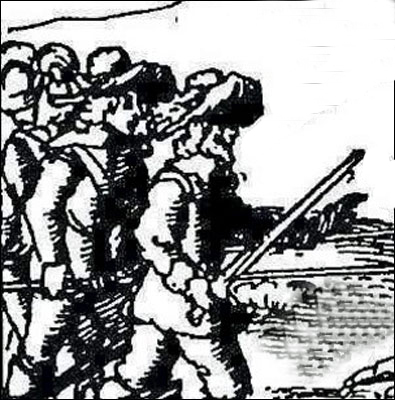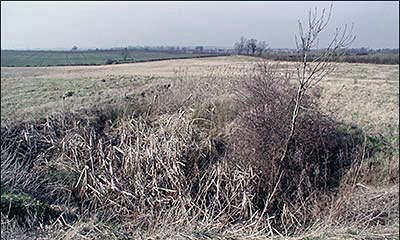|
Since before records began, it had been the custom in Burton Latimer for part of Burton Wold to be preserved for use by the landless poor to graze animals and to harvest the “furrs and thornes” that grew there. Furrs was the ancient name for furze or gorse, used in building and roofing, and thornes was usually hawthorn, used as firewood and minor repairs.
It must be remembered that at that time all land belonged to the Crown. From the nobility right down to the lords of the manor, the estates they administered had been granted to them by the monarch which meant that if their estates included a common the poorer inhabitants were able to exercise their rights to “estovers” – the right to take sufficient wood for the commoner's house or holding, usually limited to smaller trees, bushes (such as gorse) and fallen branches from the monarch's lands for their needs
Burton Wold, once referred to as the Old or Woalde, consisted of several hundred acres of common land to the southeast of the town that was administered by the church on behalf of the commoners, the vast majority of whom did not own their own land but might own a cow or pig to provide themselves with food. Adjacent to the Wold was an enclosure consisting of about four acres of land surrounded by a soil bank on which grew a hedge that acted as a safe haven for the animals that were left within its boundary. This was known as the Penn Hedge. It was maintained by the townspeople who regularly restored the bank and trimmed back the hedge in order to keep it animal-proof.
Hundreds of years before the term ‘sustainable and responsible agriculture’ became familiar, the law of estovers meant that there would be enough for everyone year on year if it was harvested in a responsible manner.
This all changed when Mr. Thomas Bacon moved from Long Buckby to became Lord of the Latimer Manor in 1627 after the death of his father Edmund, who built Burton Latimer Hall. The Latimer Manor owned a third of Burton Latimer, the other two thirds belonged to the Plessy Manor, owned by Lord Vaux of Harrowden.
The first recorded evidence that things were about to change came in 1630 when a Thomas James, a Burton Latimer labourer and tenant of Thomas Bacon, went to Kettering Market and proclaimed that he was ‘Lord of Burton Old’ and had its furze and thorns for sale. This galvanised the church officers into action and at the Quarter Sessions they had Thomas James taken before the local Justice of the Peace, the rector of Burton, Dr. Robert Sibthorpe. The court tried to get James to confess that the whole thing had been someone else’s idea (more than likely with Thomas Bacon in mind) and that he had been used as a pawn by one of his superiors. To this James answered, that “although he was a poor fellow, yet he had been bred amongst good company and had heard wise men, and could tell how to devise such a means as this, to help himself at a need, and that the richest men in Burton should know, before he had done.” He was jailed for six days in the hope that he would become an informer or face a longer term and, although there is no record of him having done so, he was still at liberty when the events described below took place.
The clearest evidence yet of Thomas Bacon’s ambition to add the Wold to his landholding occurred in 1633 when more than a hundred men and women, including Thomas James, took part in confrontation at two o’clock on a November morning when “being armed and prepared with halbertes, pikestaffs, pistols, swords, daggers and other warlike weapons”… “did march in troopes unto the said hedge called Pennhedge, and with axes hatchetttes and other instruments fitt for such purpose did cut, hew downe, dig up and distroie the said hedge…” After this, they moved on to the Wold where they… “riotouslie and unlawfullie cut down hew and destroie the ffurrs and thornes then there growing…”
 |
 |
|
The Penn Hedge Riot may have looked something like this
|
Thomas Bacon was there with the rioters making speeches and urging them on, also telling his tenants that he would put them out of their houses if they did not take part and promising money to others if they did as he asked. From evidence given later in court it would seem that Bacon also invited his neighbouring landowner Thomas Henchman of Isham to take part. This ripping out of the furze and thorns by the rioters for their own and Mr. Bacon’s use, disregarding the custom and practice of the sustainable harvesting that had gone on for years, brought him again into direct conflict with the formidable Dr. Robert Sibthorpe, other officers of the church and Mr. Thomas Baxter M.A., another prominent resident.
Mr. Baxter took Thomas Bacon to court where he was found guilty. He pleaded successfully that the rioters be let off but was forced to repair the damage and make reparations to the church, the town and the poor to the tune of £15. He also had to enter into a bond of £500 that he would in future “procure and take their theire reasonable estovers of furs and thornes upon Burton Old in such a manner as heretofore they have done and as in theire last lotte.” The series of events resulted in a proposal to appoint an "Overseer of the Thorns and Bushes" to ensure that the ancient rights of the commoners were not threatened again.
Footnote: This was taking place in the years of unrest leading up to the Civil War in 1641 and it did not help that Thomas Bacon had Puritan tendencies and Dr. Sibthorpe was a fervent Royalist. The feud between Dr. Sibthorpe and Thomas Bacon continued and it culminated in 1637 when a petition and counter-petition were presented to the Privy Council over Bacon’s objections to the 'Ship Money' tax imposed by Charles I. Bacon claimed that he objected to an unjust assessment and not to the principle of the tax, but it is clear that by setting up an independent assessment of how the tax was distributed he was trying to sabotage the process to the extent that the tax would be impossible to collect.
The court proceedings concerning the Penn Hedge and Wold disputes were recorded in Burton Latimer Churchwardens Accounts Books 1619 - 1633, which have been transcribed by Janet Meads.
Read the Accounts here.
|


